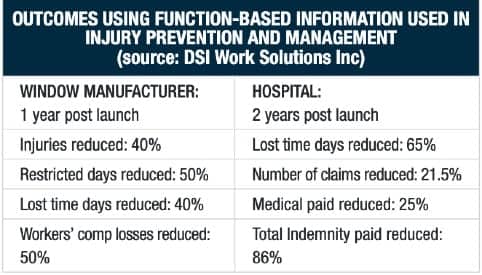By Virginia “Ginnie” Halling, PT
Workplace Injury Trends
The National Safety Council reports on its website that a job-related injury occurs every 7 seconds, that work-related injuries caused a loss of 104,000,000 production hours in 2017, and that the number one work-related injury resulting in days away from work continues to be overexertion from sprains, strains, and tears. Liberty Mutual’s 2018 Workplace Safety Index also reported that workplace injuries cost US companies an estimated $1 billion dollars each week. Clearly, there is room for improvement. In spite of those foreboding statistics, it is encouraging to know that employers are increasingly taking more proactive steps to prevent injuries. The insurance industry also continues to encourage employers to take preventive measures.
Therapists and other rehab professionals possess the skill set to assist employers with effective injury-prevention strategies and have been doing so in increasing numbers. A background in anatomy, physiology, biomechanics, disease, and injury mechanisms is a great lens through which to view work activities. When this background is combined with the ability to evaluate individuals from a musculoskeletal and functional perspective, identifying activities where ergonomic interventions should be investigated is almost second nature. Designing and delivering functional tests that match workers’ functional abilities to jobs can be straightforward and can assist employers with hiring and placement. Many rehab practices have committed to supporting employers with prevention initiatives such as these and have made significant impact.
A growing percentage of providers are being retained to assist companies across multiple sites—including at corporate levels. Some of these rehab providers have relationships with employers that span decades. Being that they are well-known to the employees, these employees are likely to make recommendations to friends and family regarding the benefits of rehab services. This can increase referrals to clinics for more traditional rehab services. It certainly would seem that failing to provide work injury prevention services is to miss significant opportunities to create relationships that can lead to increased referrals and other cash-based services.
Injury Management Challenges
Injury management strategies are equally important to controlling work injury costs and maintaining skilled workers. This is an extremely difficult area given the climate surrounding workers’ compensation laws, not to mention that these laws vary from state to state and are constantly changing.
Throughout the history of workers’ compensation the vast majority of employers, physicians, insurance representatives, and injured workers have been trying to navigate this complex arena with half of the equation missing. That “half” is objective job information that includes an accurate, adequately detailed functional and physical demands description that provides a basis for objective decision-making and testing. Simply put, a physician with this information at hand can be more objective and less conservative when determining a worker’s readiness to return to some or all of his/her work duties. This results in substantial savings in terms of direct costs such as lost time and wage replacement in addition to softer—yet very real—costs such as productivity, quality, and employee satisfaction; all of which can positively impact employee retention and reduce turnover rates.
It is in the management of workplace injuries where therapists and rehabilitation professionals have a skill set that can be challenged by few. These professionals can measure and document job functions and physical demands, identify ergonomic opportunities for prevention and/or modification, provide functional testing services, report about the worker’s ability to perform work functions safely, and counsel individual workers regarding specific work activities. This approach requires an investment of time and resources by employers and the willingness of rehab providers to provide services. The resulting outcomes speak for themselves.

The Work Injury Management Spectrum
The opportunities for effective management of work-related injuries range from an effective first aid approach to the most complex injury or illness cases requiring the skills of a reasonable accommodation expert.
Musculoskeletal Reports of Discomfort and First-Degree Sprains, Strains
There are basically two groups that fit into this level of care:
1) Workers who are experiencing soreness or other sensations with work activities or from some unknown cause. These workers are typically not interested in seeing a doctor—yet.
2) Workers who have experienced an event such as a sprain or strain from overexertion, a slip/trip or a fall—either on the job or off the job.
If the event is not serious, the worker is commonly looking for advice and reassurance.
Both occupational medicine practices and on-site rehab providers are inundated with visits from both groups. An occupational medicine physician typically assesses and advises, usually limiting intervention to consultation and (OSHA) first aid measures, if appropriate. An on-site therapist can also provide this service, referring the patient when consultation and advice beyond first aid measures are warranted. The distinct advantage of on-site services is the availability to counsel the worker specifically about their job—at their workstation. The difference in outcomes can be substantial.
Case Example
A worker who operates an industrial sewing machine reports to the occupational medicine clinic with non-specific low back and right leg pain. The worker only has 3 weeks of experience on the job. The physician does not find a specific injury and refers the worker to physical therapy. The therapist only finds the presence of lower back tightness and tenderness reported with palpation to the right hamstring and calf. The worker indicates that the frequent use of the right foot pedal causes the discomfort.
Two physical therapy visits do not produce significant results. A subsequent visit to the worker’s job reveals that the force required to depress the sewing machine pedal is significantly higher than that of other sewing machines. Maintenance assesses the situation. The malfunctioning pedal is replaced, substantially reducing the force. One week later, the worker’s symptoms are resolved.
Recovery Duty
During periods of healing/recovery time it is important to keep the worker connected to their work as closely as possible to avoid excessive restricted or days away from work. Using job function information to help assign the worker to duties related to their work (and also useful to the employer) can be accomplished with thoughtful planning by the employer as to what duties can be temporarily available to recovering workers. Treatment and/or rehabilitation services can be ongoing during this phase.
Case Example
An assembly line worker undergoes a carpal tunnel release. The physician advises 2 weeks of non-repetitive work. Rather than sending the worker home or assigning the worker to non-productive tasks, the worker is assigned to participate in functional testing and is then matched to a sub-assembly task that is offline, self-paced, and requires low grip and pinch forces with the affected hand. The physician approves the modified duty recommendation. The worker provides valuable service during the recovery period.
[sidebar float=”right” width=”250″]Product Resources
The following companies offer products and services that can be helpful for workplace ergonomics, industrial rehabilitation, and work injury assessment:
DSI Work Solutions Inc
www.dsiworksolutions.com
ErgoScience
www.ergoscience.com
JTECH Medical
www.jtechmedical.com
OPTP
www.optp.com
WorkWell Prevention & Care
www.workwell.com[/sidebar]
Expediting Return to Work
When workers have spent significant time in recovery duty or off work, routine periodic testing of the worker to their own work functions can provide physicians with useful and timely information to facilitate a timely release to full duty by specifically indicating which job functions the worker is safely able to perform. Functional goals for return to work become clear and are useful to rehab providers and physicians for guiding the return-to-work process. This approach can significantly reduce days away and restricted days while substantially increasing the likelihood of a safe and productive return to full duty.
Disability and Reasonable Accommodation
Determining a disabled worker’s ability to perform their job functions in an objective manner adds credibility to whether reasonable accommodation will result in the worker being able to perform the essential functions of the job. When job-specific functional testing is a part of the process, a rehab provider can help pinpoint areas to be considered for accommodation and participate in exploring options. This expert consultant level of work provides invaluable information to both employee and employer, and is most likely to result in a fair, unbiased outcome that is amenable to all parties.
Getting the Best
In order for the medical community, including rehab providers, to facilitate the best possible return-to-work outcomes when workers are injured or disabled, it is necessary—indeed, critical—that objective job functions and the associated physical demands be clearly defined. Costs associated with delays due to the lack of this information are a significant contributor to the high costs incurred by employers and workers today. PTP
Virginia “Ginnie” Halling, PT, is chief executive officer of DSI Work Solutions Inc. For more information, contact [email protected].





